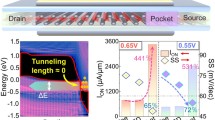Abstract
ZnMn2O4 thin films were deposited by a sol-gel technique onto a p+-Si substrate, and a RRAM device with the Ag/ZnMn2O4/p+-Si structure was fabricated. The microstructure of ZnMn2O4 films and the resistive switching behavior of Ag/ZnMn2O4/p+-Si device were investigated. ZnMn2O4 thin films had a spinel structure after annealing at 650 °C for 1 h. The Ag/ZnMn2O4/p+-Si device showed unipolar and/or bipolar resistive switching behavior, exhibiting different ION/IOFF ratio and switching endurance properties. In bipolar resistive switching, high-resistance-state (HRS) conduction was dominated by the space-charge-limited conduction mechanism, whereas the filament conduction mechanism dictated the low resistance state (LRS). For unipolar resistive switching, HRS and LRS were controlled by the filament conduction mechanism. For bipolar resistive switching, the conduction process can be explained by the space-charge region of the p-n junction.
Similar content being viewed by others
References
Liu SQ, Wu NJ, Ignatiev A. Electric Pulse Induced Reversible Resistance Change Effect in Magneto Resistive Films[J]. Appl. Phys. Lett., 2000, 76: 2 749–2 751
Waser R, Aono M. Nanoionics–based Resistive Switching Memories [J]. Nature, 2007, 6: 833–839
Liu DQ, Wang NN, Wang G, et al. Nonvolatile Bipolar Resistive Switching in Amorphous Sr–doped LaMnO3 Thin Films Deposited by Radio Frequency Magnetron Sputtering[J]. Appl. Phys. Lett., 2013, 102: 134105–1–3
Chen Q, Wang H, XU J, et al. Low Temperature Synthesis Amorphous La0.7Zn0.3MnO3 Films Grown on p+–Si Substrates and its Resistive Switching Properties[J]. J. Wuhan University of Technology–Materials Science, 2016, 31(4): 727–730
Chang WY, Lai YC, Wu TB, et al. Unipolar Resistive Switching Characteristics of ZnO Thin Films for Nonvolatile Memory Applications[J]. Appl. Phys. Lett., 2008, 92: 022110–1–3
Kukreja LM, Das AK, Misra P. Studies on Nonvolatile Resistance Memory Switching in ZnO Thin Films[J]. Bull. Master. Sci., 2009, 32: 247–252
Chen X, Wu G, Jiang P, et al. Colossal Resistance Switching Effect in Pt/spinel–MgZnO/Pt Devices for Nonvolatile Memory Applications[J]. Appl. Phys. Lett., 2009, 94: 033501–1–3
Waser R, Dittmann R, Staikov G, et al. Redox–based Resistive Switching Memories–Nanoionic Mechanisms, Prospects, and Challenges[J]. Adv. Mater., 2009, 21: 2 632–2 663
Peng HY, Wu T. Nonvolatile Resistive Switching in Spinel ZnMn2O4 and Ilmenite ZnMnO3[J]. Appl. Phys. Lett., 2009, 95: 152106–1–3
Wang H, Li Z, Xu J, et al. Resistance Switching Properties of Ag/ZnMn2O4/p–Si Fabricated by Magnetron Sputtering for Resistance Random Access Memory[J], J. Wuhan University of Technology–Materials Science, 2015, 30(6): 1 159–1 162
Luo JM, Lin SP, Zheng Y, et al. Nonpolar Resistive Switching in Mndoped BiFeO3 Thin Films by Chemical Solution Deposition[J]. Appl. Phys. Lett., 2012, 101: 062902–1–3
Ranjith R, Prellier W, Cheah JW, et al. Dc Leakage Behavior and Conduction Mechanism in (BiFeO3)m(SrTiO3)m Superlattices[J]. Appl. Phys. Lett., 2008, 92: 232905–1–3
Li YT, Long SB, Liu Q, et al. An Overview of Resistive Random Access Memory Devices[J]. China. Sci. Bull., 2011, 56: 3 072–3 078
Lee CB, Kang BS, Benayad A, et al. Effects of Metal Electrodes on the Resistive Memory Switching Property of NiO Thin Films[J]. Appl. Phys. Lett., 2008, 93: 042115–1–3
Coey JMD, Venkatesan M, Fitzgerald CB. Donor Impurity Band Exchange in Dilute Ferromagnetic Oxides[J]. Nat. Mater., 2005, 4: 173–179
Pan TM, Lu CH, Mondal S, et al. Resistive Switching Characteristics of Tm2O3, Yb2O3, and Lu2O3–Based Metal–Insulator–Metal Memory Devices. IEEE Trans. Nanotechnol., 2012, 11: 1 040–1 046
Author information
Authors and Affiliations
Corresponding author
Additional information
Funded by the National Natural Science Foundation of China (No.51262003) and the Guangxi Key Laboratory of Information Materials (Guilin University of Electronic Technology), China (No. 1110908-10-Z)
Rights and permissions
About this article
Cite this article
Zhang, Y., Wang, H., Xu, J. et al. Coexistence of Bipolar and Unipolar Resistive Switching Behavior in Ag/ZnMn2O4/p+-Si Device. J. Wuhan Univ. Technol.-Mat. Sci. Edit. 33, 1433–1436 (2018). https://doi.org/10.1007/s11595-018-1987-5
Received:
Accepted:
Published:
Issue Date:
DOI: https://doi.org/10.1007/s11595-018-1987-5




